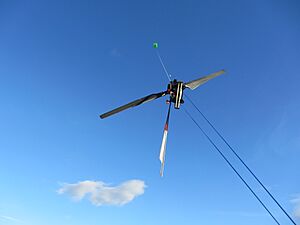Airborne wind turbine facts for kids
An airborne wind turbine is a cool idea for making electricity from wind. Imagine a wind turbine that floats high in the sky, without needing a tall tower! These special turbines can catch stronger, steadier winds found far above the ground. This also means we don't need to build expensive towers.
Sometimes, the machine that makes electricity (the generator) stays on the ground. Other times, it flies up with the turbine. A big challenge is keeping these turbines safely hundreds of meters up in the air, especially during strong winds or storms. We also need to figure out how to send the electricity they make back down to Earth. Another thing to consider is making sure they don't get in the way of airplanes.
Airborne wind turbines can work at different heights. They are part of a bigger group called Airborne Wind Energy Systems (AWES). These systems include crosswind kite power and other ways to use high-altitude winds. If the generator is on the ground, the flying part doesn't need to carry heavy equipment. Also, the rope (called a tether) connecting it to the ground doesn't need to carry electricity. If the generator is up high, then the tether must be able to send power down.
Things like kites and helicopters can fall if there isn't enough wind. Special balloons called kytoons or blimps might help keep them up. However, bad weather like lightning or thunderstorms could mean these machines have to be brought down. As of 2015, no airborne wind turbines were being used regularly to make power for homes or businesses.
Contents
How Airborne Wind Turbines Work
There are two main ways airborne wind turbines are designed:
Aerodynamic Systems
An aerodynamic airborne wind system uses the wind to stay up in the air.
In one type, the generator is up in the sky. A flying shape, like a kite, is tied to the ground. This kite catches the wind and helps a wind turbine make energy. In another type, like Crosswind kite power, the generators are on the ground. Here, one or more kites pull on a tether. This pulling motion is then turned into electricity.
If the turbine is in the air, the tether needs to have wires inside to send power to the ground. Systems that use a winch (a machine that pulls a rope) can keep the heavy generator on the ground. In these cases, the tethers don't need to carry electricity.
Scientists and engineers have been studying aerodynamic wind energy systems since at least 1980. Many ideas have been suggested, but no products are widely available yet.
Other projects working on airborne wind energy systems include:
- KiteGen
- Rotokite
- HAWE System
- SkySails
- X-Wind technology
- Makani Power crosswind hybrid kite system
- Windswept and Interesting Kite Ring
- Kitemill
Aerostat Systems
An aerostat-type wind power system uses buoyancy (like a balloon floating) to help keep the wind-collecting parts in the air. Aerostats are designed in different ways. Some shapes can even "kite" in the wind, helping them stay up. A famous example of these kiting balloons is the kytoon, invented by Domina Jalbert.
Balloons can help keep these systems up even when there's no wind. However, balloons slowly leak gas and need to be refilled. They might also need to be patched. Very large balloons that are heated by the sun could help solve the problem of gas leaking.
A company from Ontario, Canada, called Magenn, was working on a turbine called the Magenn Air Rotor System (MARS). They planned for a large MARS system, about 300 meters (1000 feet) wide. It would use a horizontal rotor inside a helium-filled balloon. This balloon would be tied to a transformer on the ground. Magenn said their technology could make a lot of power even with slow winds. They also claimed it was more efficient because it could fly higher than regular wind turbines. The first test models were built in April 2008. However, no MARS units have been sold.
Another company, Altaeros Energies, based in Boston, uses a helium-filled balloon to lift a wind turbine. The power it makes is sent down to a base station using the same cables that control the balloon. In 2012, they flew and tested a 10.6-meter (35-foot) test model. This model used a standard Skystream 2.5kW 3.7m wind turbine. In the fall of 2013, Altaeros started working on their first full-size test in Alaska.
See also
 In Spanish: Aerogenerador volante para niños
In Spanish: Aerogenerador volante para niños
Images for kids



